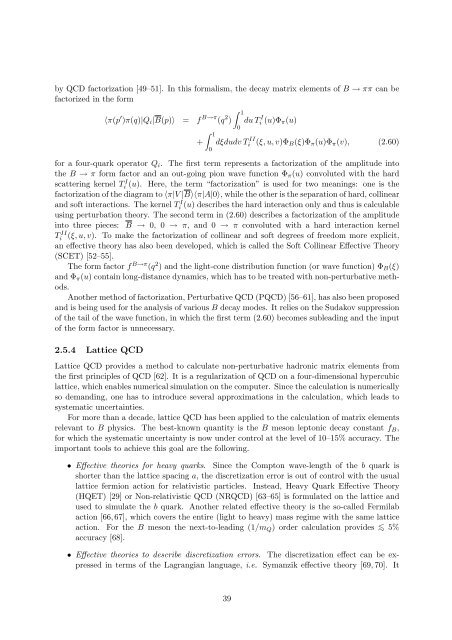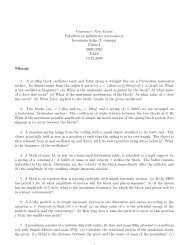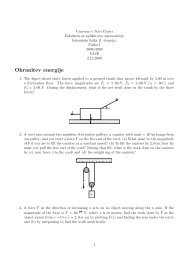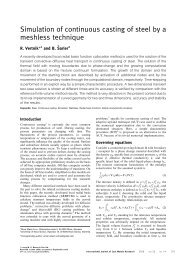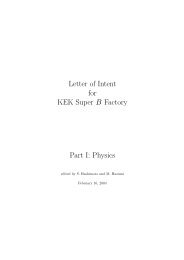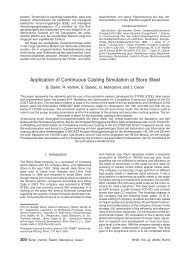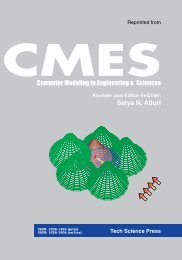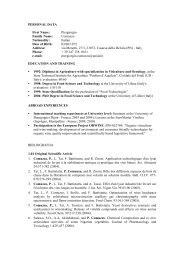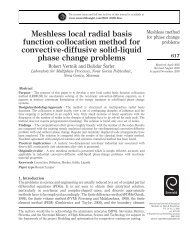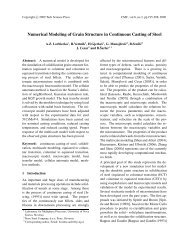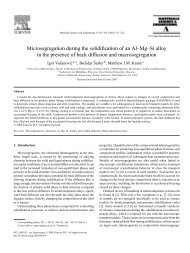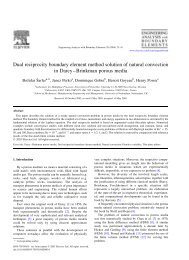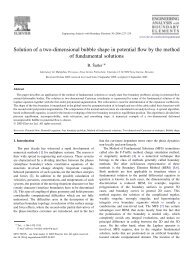Letter of Intent for KEK Super B Factory Part I: Physics
Letter of Intent for KEK Super B Factory Part I: Physics
Letter of Intent for KEK Super B Factory Part I: Physics
Create successful ePaper yourself
Turn your PDF publications into a flip-book with our unique Google optimized e-Paper software.
y QCD factorization [49–51]. In this <strong>for</strong>malism, the decay matrix elements <strong>of</strong> B → ππ can be<br />
factorized in the <strong>for</strong>m<br />
〈π(p ′ )π(q)|Qi|B(p)〉 = f B→π (q 2 1<br />
) du T<br />
0<br />
I<br />
i (u)Φπ(u)<br />
1<br />
+ dξdudv T<br />
0<br />
II<br />
i (ξ, u, v)ΦB(ξ)Φπ(u)Φπ(v), (2.60)<br />
<strong>for</strong> a four-quark operator Qi. The first term represents a factorization <strong>of</strong> the amplitude into<br />
the B → π <strong>for</strong>m factor and an out-going pion wave function Φπ(u) convoluted with the hard<br />
scattering kernel T I<br />
i (u). Here, the term “factorization” is used <strong>for</strong> two meanings: one is the<br />
factorization <strong>of</strong> the diagram to 〈π|V |B〉〈π|A|0〉, while the other is the separation <strong>of</strong> hard, collinear<br />
and s<strong>of</strong>t interactions. The kernel T I<br />
i (u) describes the hard interaction only and thus is calculable<br />
using perturbation theory. The second term in (2.60) describes a factorization <strong>of</strong> the amplitude<br />
into three pieces: B → 0, 0 → π, and 0 → π convoluted with a hard interaction kernel<br />
(ξ, u, v). To make the factorization <strong>of</strong> collinear and s<strong>of</strong>t degrees <strong>of</strong> freedom more explicit,<br />
T II<br />
i<br />
an effective theory has also been developed, which is called the S<strong>of</strong>t Collinear Effective Theory<br />
(SCET) [52–55].<br />
The <strong>for</strong>m factor f B→π (q2 ) and the light-cone distribution function (or wave function) ΦB(ξ)<br />
and Φπ(u) contain long-distance dynamics, which has to be treated with non-perturbative methods.<br />
Another method <strong>of</strong> factorization, Perturbative QCD (PQCD) [56–61], has also been proposed<br />
and is being used <strong>for</strong> the analysis <strong>of</strong> various B decay modes. It relies on the Sudakov suppression<br />
<strong>of</strong> the tail <strong>of</strong> the wave function, in which the first term (2.60) becomes subleading and the input<br />
<strong>of</strong> the <strong>for</strong>m factor is unnecessary.<br />
2.5.4 Lattice QCD<br />
Lattice QCD provides a method to calculate non-perturbative hadronic matrix elements from<br />
the first principles <strong>of</strong> QCD [62]. It is a regularization <strong>of</strong> QCD on a four-dimensional hypercubic<br />
lattice, which enables numerical simulation on the computer. Since the calculation is numerically<br />
so demanding, one has to introduce several approximations in the calculation, which leads to<br />
systematic uncertainties.<br />
For more than a decade, lattice QCD has been applied to the calculation <strong>of</strong> matrix elements<br />
relevant to B physics. The best-known quantity is the B meson leptonic decay constant fB,<br />
<strong>for</strong> which the systematic uncertainty is now under control at the level <strong>of</strong> 10–15% accuracy. The<br />
important tools to achieve this goal are the following.<br />
• Effective theories <strong>for</strong> heavy quarks. Since the Compton wave-length <strong>of</strong> the b quark is<br />
shorter than the lattice spacing a, the discretization error is out <strong>of</strong> control with the usual<br />
lattice fermion action <strong>for</strong> relativistic particles. Instead, Heavy Quark Effective Theory<br />
(HQET) [29] or Non-relativistic QCD (NRQCD) [63–65] is <strong>for</strong>mulated on the lattice and<br />
used to simulate the b quark. Another related effective theory is the so-called Fermilab<br />
action [66, 67], which covers the entire (light to heavy) mass regime with the same lattice<br />
action. For the B meson the next-to-leading (1/mQ) order calculation provides < ∼ 5%<br />
accuracy [68].<br />
• Effective theories to describe discretization errors. The discretization effect can be expressed<br />
in terms <strong>of</strong> the Lagrangian language, i.e. Symanzik effective theory [69, 70]. It<br />
39


